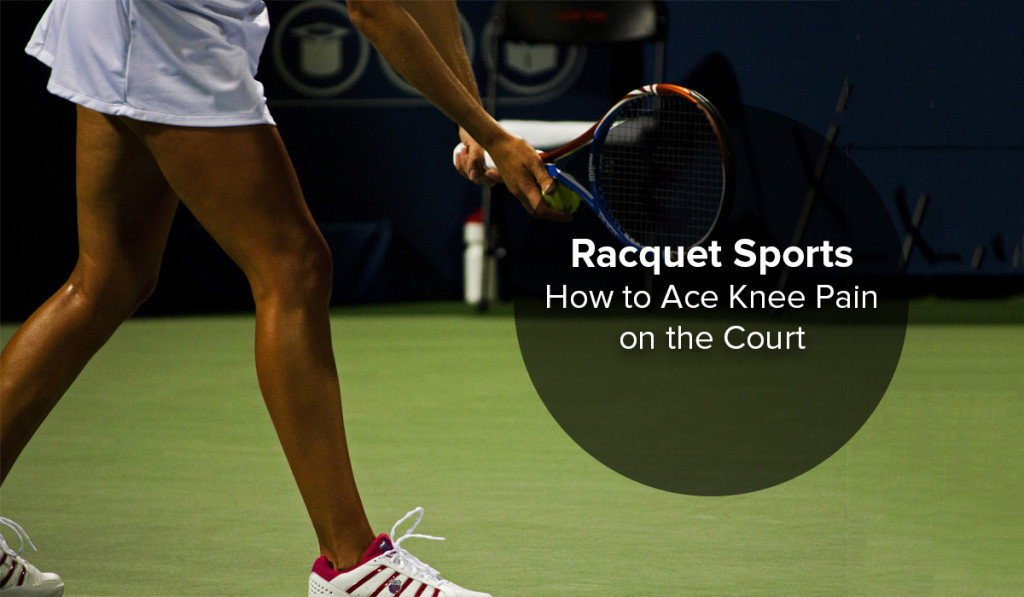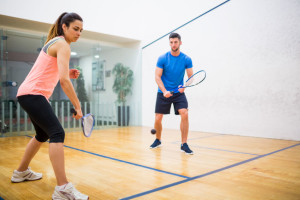Racquet Sports – How To Ace Knee Pain On The Court

Do you play racquet sports? Tennis, squash, racquetball or badminton? If you do, you may find the sport is hard on your knees. Racquet sports are some of the most popular sports in the world and competitive matches are played even at a mature age. Because racquet sports are so fast-paced and difficult on the knees, injuries can occur at any time and at any age. Some of the world’s greatest tennis players have taken time off or retired from the sport due to knee injuries. It’s not surprising: as a tennis and squash player myself, I have been somewhat unkind to my knees in the past: there is just so much twisting, turning, changing direction and lunging! In a nut-shell, those who play racquet sports are known to be at a higher risk of injury due to the unique demands on their knees. So, what can you do to prevent or reduce the risk of knee injuries?
Racquets and Risk

Our knees are essential when playing tennis, squash, racquetball or badminton. The knee must endure significant forces (from almost every angle!) for an extended period of time. These forces occur from the fast-starting, stopping, twisting, pivoting and quick changes of direction involved in racquet sports. Playing at a fast pace requires rapid and precise movements that put quite a bit of strain on the joint.
What’s the Damage?
Jumper’s knee (formally known as patellar tendonitis) is the most common type of knee injury among athletes in racquet sports. Jumper’s knee is pain in the tendon that attaches the kneecap to the top of the shin. Ligament tears are also common among racquet sport athletes. Ligament tears are commonly experienced when stopping, starting and quickly changing direction. These rapid movements put extreme forces on the knee, which can result in torn ligaments (most commonly anterior cruciate ligament (ACL) and medial cruciate ligament (MCL) tears). Meniscus tears can also occur as a result of twisting, pivoting, decelerating quickly or sudden impact on the knee. So how can we reduce the risk of injury?
Learn about all possible causes of knee pain on the front of the joint
Reducing Risk of Injury
There are many different approaches that athletes can take to reduce injury. With proper training, stretching and cool down following workouts, the chance of knee injury is greatly decreased. This includes:
- Regular stretching and strengthening of the leg muscles. To ensure the knee is working productively and efficiently, it is important the leg muscles around the knee such as the quadriceps (upper thigh) and hamstrings (rear thigh) are strong and flexible.
- Thorough warm up and cool down before and after physical activity. It is important that the body is warmed up and ready to go, which can decrease the chance of muscle and ligament tears during workouts (tennis, squash, badminton, racquetball) and a cool down will ease the muscles at the end of athletic activities.
- Agility and flexibility training. Cross training to improve agility and flexibility can help improve technique on the court, and as a result, help your game and decrease the chance of injury.
- Footwear is key. Wearing appropriate comfortable footwear is one easy way to reduce the risk of injury. Good court shoes are flat footed and have supports for your foot and ankle to help prevent slipping, falling or rolling over ankles.
If you experience any sign of pain in the knee, take the weight off your knee and follow the R.I.C.E (Rest, Ice, Compression, Elevation) method for immediate recovery and relief. If you think you’ve torn a ligament or done something else serious to your knee, check out our other blog posts on a knee injury and be sure to consult with a physiotherapist or doctor. Staying active and playing a sport that you love can be very rewarding, be sure to stay safe and injury free on the court.

Frequently Asked Questions
Jumper’s knee is a common knee injury among athletes caused by damage to the tendon that attaches the kneecap to the shin bone.
Regular stretching, strengthening, and proper warm-up and cool-down exercises are among many approaches that can reduce the risk of injuries from racquet sports.
Resting, icing, compressing, and elevating the affected knee joint can help provide immediate relief of knee pain caused by racquet sports. If serious injury to the knee is suspected, consult your healthcare provider for appropriate diagnosis and treatment.